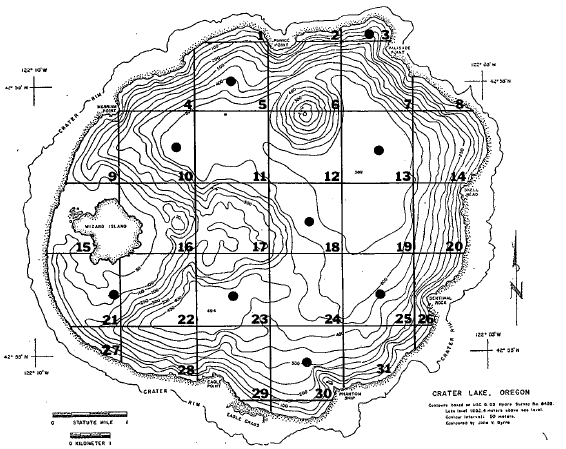The Horizontal Distribution and Vertical Migrations of the Limnetic Zooplankton in Crater Lake, Oregon by F. Owen Hoffman
METHODS
All field data were collected during the summers of 1967 and 1968. Sampling before mid-June or after early September was virtually impossible because of the extreme weather conditions during the long winter season that impair access to the lake. Most of the data obtained in 1967 were the results of exploratory efforts. For convenience in sampling, the lake was divided into one mile square sections. These were numbered consecutively and referred to a s stations (Figure 1).
Horizontal Distribution
During the investigations of the horizontal distribution of zooplankton, six stations in 1967 and nine in 1968 were arbitrarily selected to represent a variety of conditions throughout the lake and give an even distribution to the sampling effort. Stations 5, 10, 13, 18, 22, and 25 were sampled in 1967. Stations 3, 5, 10, 13, 18, 21, 23, 25, and 30 were sampled in 1968. During each summer the sampling was repeated five times at intervals of two to three weeks.
Figure 1. Sampling grid of Crater Lake showing the zooplankton sampling stations
Samples were obtained with a standard plankton tow net 1 /2-m in diameter, with a No, 20 nylon mesh (0. 076 mm aperture). The net was towed vertically from 100 m to the surface a t each station sampled. Two samples at each station were taken on August 26, 1967 and August 27 and 28, 1968, to obtain some estimate of sampling error. Only one sample per station was collected on all other dates.
Vertical Distribution
When sampling the vertical distribution it was necessary to tow the net horizontally in order to catch sufficient quantities. of zooplankton. At first, vertical tows were made with a 112-m diameter closing net (No. 20 mesh nylon). But, too few organisms were caught to give meaningful results, and the use of the closing net was discontinued. Exploratory horizontal tows were taken on July 24, 1967. A standard 112-m diameter tow net with a No. 6 nylon mesh (0. 239 mm aperture) equipped with a T. S. flow-meter (Tsurumi-Seiki Kosakusho Go., Ltd.) was used to sample different depths at several locations in the lake (Figure 2a).
The sampling process involved lowering the net vertically to the desired depth. Then, more cable was slowly released to maintain the net at depth as the forward motion of the boat brought the angle of the towing cable to 60 degrees. The cable length at 60 degrees is twice the vertical depth.
The first meaningful series of horizontal tows was made on July 28, 1967. All sampling was restricted to station 13 (Figure 1). Two series of seven tows were made at a range of depths from 200 to 25 m a t 1020 to 1255 hours, and at 2200 to 2435 hours.


